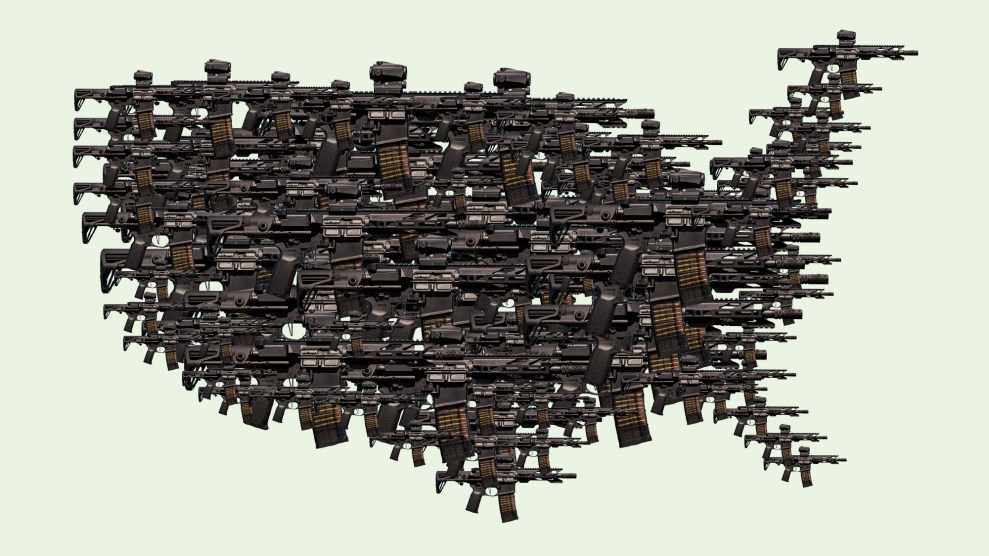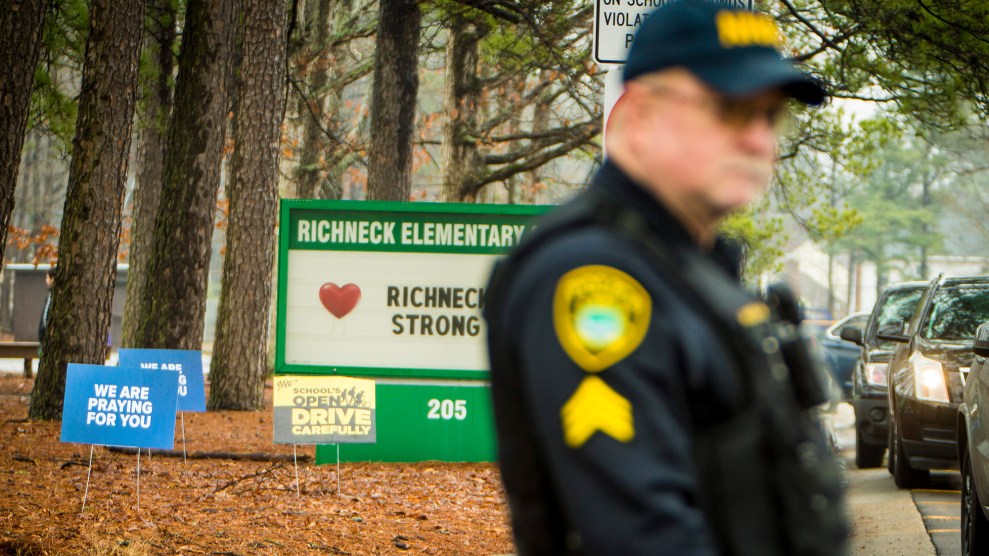
Mother Jones; Unsplash
One year after a suicidal 18-year-old opened fire with an AR-15 rifle inside Robb Elementary School, most of the public discussion remains focused on how a swarm of law enforcement failed for more than an hour to put an end to the attack. By the time police finally went into the classroom and killed the gunman, 19 children and two teachers were dead and many other people were injured and traumatized.
That catastrophic dereliction of duty demands scrutiny and accountability on multiple levels. The excruciatingly slow response violated a fundamental doctrine that was adopted widely after the Columbine High School massacre in 1999, which holds that police on the scene must move immediately to confront an active shooter—a situation in which every lost second counts. The lack of such action in Uvalde undoubtedly worsened the death toll. In the aftermath, Texas law enforcement officials spread inaccurate information and stonewalled the media and public about what had happened. Last summer, when the first major state investigation of the tragedy went public, Texas lawmakers tried to bury the finding that multiple police officers were unwilling to confront the shooter because they feared the firepower of his AR-15—which he’d bought legally immediately upon turning 18, shortly before he attacked.
Stark lessons from the disgraceful response that day will continue to emerge. Another crucial side of the Uvalde tragedy, however, remains far too obscured: the distinct possibility that an array of warning signs from the perpetrator could have led authorities to prevent the massacre.
As I wrote previously, publicly known case evidence makes clear that Salvador Ramos, once a student himself at Robb Elementary, needed help long before he spiraled deeper into a crisis and began planning the mass shooting. A troubled person’s often lengthy pathway to attack—and potential opportunities for trained experts to intervene—can be understood clearly through the research and case work of behavioral threat assessment. In Trigger Points, my book about preventing mass shootings, I explore eight broad areas of warning signs that threat assessment teams rely on to evaluate and manage individuals who are mired in rage, despair, and other problems, and whose suicidal intent can also turn homicidal. The method has been used to remarkable effect with constructive interventions by teams throughout the country, as I chronicle in the book.
The warning signs, often observable to people around a would-be perpetrator, range from threatening communications and emulation of previous attackers (the so-called “copycat” problem), to personal deterioration, triggering events, and, finally, methodical preparation for the attack. Ramos’ actions and circumstances checked all those boxes. His identifiable behaviors included several that are prevalent among mass shooters, including a focus on violent misogyny, the seeking of media attention and notoriety, and a fixation on military-style weapons and tactical gear. (I documented those and other details from his case here.)
The various red flags that precede virtually every mass shooting of this kind are easier to see in hindsight. Yet, greater public awareness of them could go a long way toward encouraging people to speak up and reach out for help when they feel concern or fear about a troubled individual who might be turning dangerous.
In the case of Uvalde, there is more such evidence that is not currently known to the public. According to a source familiar with an ongoing law enforcement investigation, Ramos had extensive contact online with at least one young person who may well have seen indications of his deadly plans. This person “knew him quite well,” the source told me.
Whether the person realized the danger or felt compelled to sound an alarm is unclear. With school shootings, there is a long history of so-called “bystanders” who, for a variety of reasons, did not seek help from an authority figure. In some cases, whole groups of high school kids had indications of an approaching school shooting and didn’t act.
One lingering question is whether the Uvalde school district had adequate prevention protocols in place, as required by a Texas law enacted in 2019. The committee from the Texas House of Representatives detailed in its July 2022 investigation that the district had adopted a “viable” policy for “responding to an active shooter emergency.” As I reported previously:
That included threat assessment protocols, according to the Uvalde policy: “Every campus employs an interdisciplinary team of trained professionals that convene to identify, evaluate, classify and address threats or potential threats to school security. Following assessment, this team determines appropriate response and intervention. This includes notification and involvement of parents, a suicide risk assessment, and the development of a written safety plan.”
Ramos had no criminal record and was no longer enrolled in Uvalde High School as of about seven months before his attack. It is unclear whether he was previously the subject of a threat assessment investigation, and, if so, how his case was handled. A spokesperson I reached with the Uvalde school district declined to comment.
A government official in Texas with knowledge of the matter later told me that no threat assessment program existed in the school district or local community prior to the mass shooting. (The school district did not respond to a follow-up request for comment.)
State-required threat assessment in school systems is a growing but relatively new and untested policy; in communities like Uvalde and Newport News, Virginia—where a 6-year-old child shot his first-grade teacher in January—a lack of resources can be an added barrier to standing up threat assessment programs.
Investigations into the law enforcement meltdown in Uvalde are continuing, including one by the US Department of Justice. According to a source familiar with the DOJ effort, investigators have also looked into some circumstances and developments with the perpetrator leading up to the massacre. But that is not the primary focus, and it remains to be seen whether a public report will include those elements to any degree. The source declined to comment about when the investigation may be completed; thus far, the DOJ has not specified a date.
Among the questions still hanging most heavily over the tragedy: How could such a troubled young person so quickly and easily acquire a highly lethal arsenal?
Republican leaders in Texas and elsewhere have long been hostile to gun-violence prevention policies such as red flag laws and raising the legal age for gun buyers from 18 to 21. In siding with the gun industry, they defy broad bipartisan support among the American public for such measures. The implications of their position couldn’t be more glaring than with the Uvalde massacre, as the Texas House committee’s own report showed. Beginning the day Ramos turned 18, according to the report, he armed himself heavily for the attack he would carry out eight days later:
An online retailer shipped 1,740 rounds of 5.56mm 75-grain boat tail hollow point to his doorstep, at a cost of $1,761.50. He ordered a Daniel Defense DDM4 V7 (an AR-15-style rifle) for shipment to a gun store in Uvalde, at a cost of $2,054.28. On May 17, 2022, he bought a Smith and Wesson M&P15 (also an AR-15-style rifle) at the same store in Uvalde, at a cost of $1,081.42. He returned the next day for 375 rounds of M193, a 5.56mm 55-grain round with a full metal jacket, which has a soft core surrounded by a harder metal. He returned again to pick up his other rifle when it arrived on May 20, 2022, and he had store staff install the holographic sight on it after the transfer was completed.
As I’ve documented recently, in the past year alone there have been at least eight gun massacres in public places in America committed by heavily armed shooters who used AR-15s and tactical gear, an escalating trend. The perpetrators have mostly been suicidal young adults, including three who were 18 years old. The latest one fatally shot three people and injured six others on May 15 in Farmington, New Mexico, where he screamed for police to kill him as they took him out in a gun battle. His was another textbook case of warning signs tragically missed or unheeded.
A reckoning still awaits for how law enforcement responded to the school massacre in Uvalde. The same should be true for the failure to prevent it from ever happening at all.













